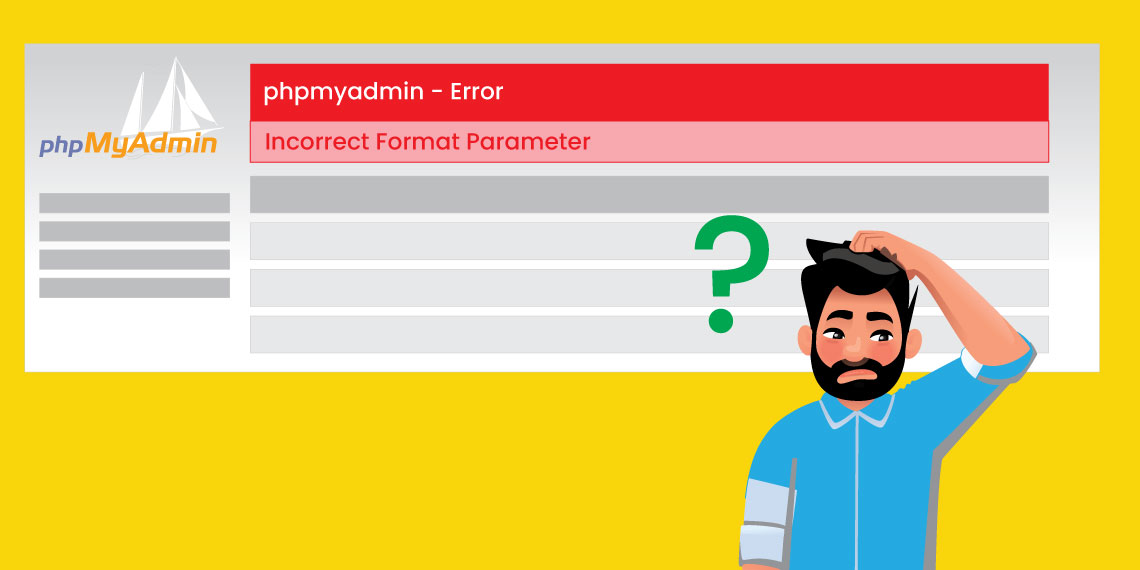Resolving the phpMyAdmin errors can be tricky. While importing the database backup file using PhpMyAdmin, you may get the phpMyAdmin error incorrect format parameter. Generally, you may get plagued with the concerned error when importing large database files.
The Incorrect Format Parameter error may appear on various hosting platforms. These include platforms like a dedicated server, localhost, VPS, or shared hosting. The error may display when uploading a database with a greater than max upload size. It might also occur on importing a large MySQL database in XAMPP or MAMP on the above-mentioned hosting platforms.

This article further elaborates on what are the causes of incorrect format parameter phpMyAdmin error. You will also understand the process of resolving it in your local environment of XAMPP.
What is phpMyAdmin?
phpMyAdmin is widely popular. It is an open-source tool, so comes free. It helps manage and administer the databases like MariaDB and MySQL database application systems. It provides multiple-server administration. Moreover, the interface is intuitive and allows easy management of the database. Importing backups to the server is also supported by phpMyAdmin.
What leads to phpMyAdmin error – Incorrect format parameter?
There are multiple reasons why this exception occurs. Here are the most prevalent and known causes which can trigger this error. These include:
If the script needs operating memory greater than what is defined in the memory limit.
If the execution of the script takes longer than the set determined time for execution.
If the parsing of input data you have requested takes more than the set limit for parsing time.
If the size of post data exceeds the defined size of post data.
When the file size is greater than the defined limit of file size.
If there is a corruption of the MySQL database.
How do you resolve it?
There are various proven steps to effectively fix the given phpMyAdmin error. These are:
Increasing the limits of PHP
The settings mentioned above get defined in php.ini file. Their path takes place via xampp/php/php.ini. At times, you may find that the defined PHP parameters such as maximum execution time, upload file size, and memory limit may not meet your requirements. In such circumstances, you must redefine the limits of PHP in php.ini file.
Thus, initially, you must check the PHP parameters. Based on the server you need to look into, it will determine the exact location of the PHP configuration. The php.ini file location varies for different categories of servers. To locate the loading path of php.ini, you can create a PHP info file in the domain’s webroot.
You can choose the alter the given parameters according to specific needs. For example,
- Max_execution_time = 3000
- Max_input_time = 600
- Memory_limit = 128M
- Post_max_size = 200M
- Upload_max_filesize = 200M
If you are unable to access the php.ini file, alternatively, you can change the settings parameters in .htaccess file if it’s Apache webserver, like the following:
- Php_value max_execution_time = 3000
- Php_value max_input_time = 600
- Php_value memory_limit = 128M
- Php_value post_max_size = 100M
- Php_value upload_max_filesize = 100M
According to the size of your database, make the settings. Once you do it, you can proceed to save the file. On importing the SQL file, now, you will find that it gets imported correctly without any error.
For avoiding issues with websites, ensure that you back up the configuration files before making any edits. Also, note that you can set the PHP parameters as maximum as possible, but once you complete the work, revert it to the original settings.
Compress SQL file
If you face any error due to large file size, compressing the SQL file (into .zip) before uploading can fix the issue. Directly importing the compressed file is supported on PHPMyAdmin. It is also the right recourse if your server does not facilitate changing PHP configuration. When naming the compressed file, it must be similar to something like this: db-name.sql.zip.
Possibly Corrupt SQL
While generally resetting the PHP parameters fixes the error, sometimes it may not be enough. At times, corrupt SQL files may cause this error. Back up the database afresh in such cases. It will enable the replacement of the present database file with an updated SQL backup file. You may rebuild the SQL script if certain issues continue to persist because of an anomaly in the SQL file.
Manual SQL Import with SSH
In certain instances, the listed solutions may fail to work. Thus, the only way left is to use the SSH option to import the database backup manually.
Summary:
Based on your situation, you can leverage the right step to fix the ‘phpMyAdmin error Incorrect Format Parameter’ to eliminate it so that you can seamlessly import the database file.
